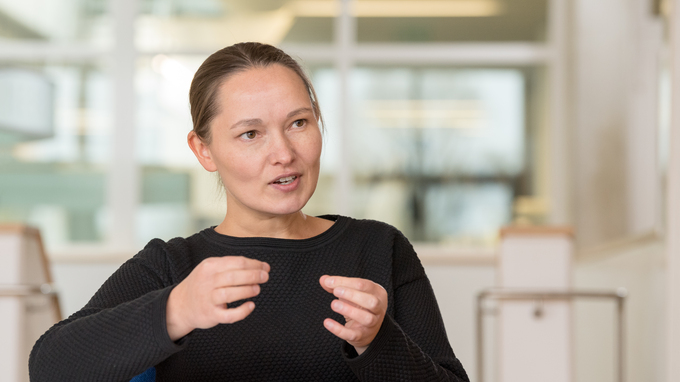Interdisziplinäres Studium und sehr gute Berufsaussichten
Prof. Julia Herzen über den neuen Master „Biomedical Engineering and Medical Physics“
2019-11-16 – Nachrichten aus dem Physik-Department
Der neue Masterstudiengang heißt “Biomedical Engineering and Medical Physics”. Was sollen die Studierenden hier lernen?
Mit diesem forschungsorientierten und interdisziplinären Studiengang wollen wir die Studierenden auf Jobs in Forschung und Industrie vorbereiten, in Bereichen wie Biomedizinische Technik oder Medizinphysik. Und dafür möchten wir ihnen insbesondere die nötigen Grundlagen in Biologie, Physik und den Ingenieurwissenschaften mitgeben, die sie für den Beruf brauchen.
Die Absolventen und Absolventinnen werden also vor allem neue medizinische Geräte entwickeln?
Es geht um mehr. Wenn wir sagen, dass das ein forschungsorientierter Studiengang ist, bedeutet das, dass wir die Entwicklung von Methoden für die biomedizinische Technik fördern wollen. Die Studierenden sollen lernen, physikalische Konzepte zu verstehen, diese dann mit den Methoden der Ingenieurwissenschaften umzusetzen und in einer für die Medizin nützlichen Weise anzuwenden.
Biomedizinische Technik ist ein weites Feld. Welche besonderen Schwerpunkte wird es im Studium geben?
Am Anfang können die Studierenden zwischen den Schwerpunkten Biomedizinische Bildgebung und Biosensorik wählen. Der Studiengang ist aber flexibel angelegt, so dass sich die Schwerpunkte mit der Zeit auch verändern können.
Wieso ist die Interdisziplinarität so wichtig?
Weil es nichts nützt, wenn ich als Physikerin eine neue Methode entwickle, die man dann in der medizinischen Praxis nicht gebrauchen können. Ich muss von Anfang an mit Ärztinnen und Ärzten zusammenarbeiten, um zu einer nützlichen Anwendung zu kommen. Damit die Zusammenarbeit funktioniert, müssen die Beteiligten eine gemeinsame Sprache finden – die Ingenieurinnen und Ingenieure müssen die Sprache der Medizin verstehen und die Physikerinnen und Physiker die der Ingenieurwissenschaften. Und wenn sie das nicht schon im Studium lernen, kostet sie das später sehr viel Zeit.
Wie spiegelt sich die Interdisziplinarität in der Organisation des Studiengangs wider?
Der Studiengang ist zwar organisatorisch an die Fakultät für Physik angegliedert, aber die Studierenden werden Vorlesungen an verschiedenen Fakultäten wie zum Beispiel beim Maschinenwesen besuchen und auch am Klinikum rechts der Isar. Der Studiengang ist auch eng mit der MSB, der Munich School of BioEngineering, verbunden, in der der interdisziplinäre Ansatz schon lange gelebt wird. Die Studierenden werden zum Beispiel ihre Masterarbeiten bei allen Mitgliedern der MSB schreiben können – also auch bei denen, die nicht an der Fakultät für Physik tätig sind. Das ist für einen Physik-Studiengang wirklich neu.
Neu ist auch das Konzept für das Physik-Praktikum.
Ja. Üblicherweise lernen Studierende im Praktikum in einzelnen Experimenten verschiedene Aspekte der Physik kennen. Das wollten wir anders machen: Unsere Studierenden werden jeweils einen Versuch durchführen, der entsprechend aufwendig ist, und der sie an Projekte heranführt, denen sie in Forschung und Industrie begegnen werden. Ein Beispiel ist, dass eine Studentin ihren Versuch an einem Computertomografie-Gerät durchführt: Sie charakterisiert das Gerät, lernt, die geeignete Dosis für einen Patienten zu bestimmen, und sich dann eigenständig erarbeitet, eine moderne Untersuchungsmethode an diesem Gerät anzuwenden.
Der Studiengang wird auf Englisch angeboten. Was sind die Gründe dafür?
Wir wollen internationaler werden. In der Region gibt es bisher wenige englischsprachige Studienangebote in Biomedizinischer Technik und wir konnten beobachten, dass ein anderer englischsprachiger Physikstudiengang an der TUM sehr viele gute Studierende angezogen hat. Zudem gibt es in den Nachbarländern einige sehr gute spezialisierte Bachelorstudiengänge. Die Absolventinnen und Absolventen bringen die nötigen Grundlagen für unseren Studiengang mit, und wir würden einige von ihnen gerne für uns gewinnen.
Welche Voraussetzungen müssen die Bewerberinnen und Bewerber mitbringen, um im Studium erfolgreich zu sein?
Man braucht nicht unbedingt einen Bachelor in Physik - wir würden uns freuen, wenn sich auch Studierende mit Abschlüssen in Biologie, Chemie oder Informatik bewerben. Wichtig ist, dass die Bewerberinnen und Bewerber gutes Basiswissen in Mathematik und Physik mitbringen, auch ein wenig Chemie, Biologie, Physiologie. Sie sollten also zum Beispiel wissen, wie Zellen funktionieren, wie sie sich vermehren oder wie sie sterben. Wichtig ist auch Erfahrung im Labor, ob aus dem Studium oder einem Praktikum in der Industrie. Wer diese nicht hat, wird sich im Praktikum sehr schwertun. Die Details zu den Voraussetzungen und dem Bewerbungsverfahren findet man auf der Webseite.
Wie sehen die Berufsaussichten nach dem Master aus?
Die Chancen für die Absolventinnen und Absolventen sind wirklich sehr gut. Es gibt bei Medizintechnikunternehmen eine große Nachfrage nach Fachleuten in Biomedizinischer Technik und verwandten Fächern – gerade hier im süddeutschen Raum. Und es gibt auch viele Möglichkeiten in der Wissenschaft, zum Beispiel bei den Fraunhofer-Instituten, den Max-Planck-Instituten oder den Helmholtz-Zentren.
In unserer Arbeitsgruppe werden seit zehn Jahren Masterstudierende in biomedizinischer Bildgebung betreut. Einige sind in der Wissenschaft geblieben und arbeiten in den USA oder Großbritannien. Die anderen sind in der Industrie tätig – zum Teil außerhalb der Medizintechnik. Zum Beispiel unterhalten auch Automobilhersteller Computertomografie-Labore für die Materialforschung. Und auch der Bedarf an Fachleuten in Gebieten wie Bildverarbeitung, Bilderkennung oder künstliche Intelligenz wird immer größer.
- Interview
- Dr. Paul Piwnicki
Über die Person
Die Physikerin Julia Herzen ist Professorin für Biomedizinische Bildgebung an der Technischen Universität München und Studiengangsverantwortliche für den Masterstudiengang “Biomedical Engineering and Medical Physics”. In ihrer Forschung beschäftigt sie sich mit der Weiterentwicklung der Röntgen-Computertomographie, für die sie sich verschiedene physikalische Phänomene wie zum Beispiel den Phasenkontrast zu Nutze macht. Dabei konzentriert sie sich zurzeit auf verbesserte Verfahren für die Brustkrebs-Diagnostik und Methoden für die dreidimensionale Darstellung histologischer Proben.
Weitere Informationen
Die Bewerbungsfrist für den Masterstudiengang “Biomedical Engineering and Medical Physics” für den Studienbeginn zum Sommerssemester 2020 endet am 30. November 2019.
- Darstellung des Studiengangs auf der Seite der Munich School of BioEngineering (in Englisch)
- Detaillierte Informationen zu dem Studiengang auf der Seite des Physik-Departments – mit genauen Angaben zum Curriculum und zum Bewerbungsverfahren.
- Professorenprofil Julia Herzen
- Munich School of BioEngineering (in Englisch)
Kontakt
Verwandte Meldungen
- Histologie in 3D – 2018-02-22
- Grundsteinlegung für „TUM Center for Functional Protein Assemblies“ – 2017-10-25
- Nano-CT im ersten Praxistest – 2017-10-07
- Leibniz-Preisträger Franz Pfeiffer leitet Munich School of BioEngineering – 2017-03-30
